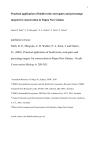A conservation planning study in Papua New…
A conservation planning study in Papua New Guinea (PNG) addresses the role of
biodiversity surrogates and biodiversity targets, in the context of the trade-offs required
for planning given real-world costs and constraints. In a trade-offs framework, surrogates
must be judged in terms of their success in predicting general biodiversity
complementarity values – the amount of additional biodiversity an area can contribute to
a protected set. Wrong predictions of low complementarity (and consequent allocation of
non-protective land uses) may be more worrisome than wrong predictions of high
complementarity (and consequent allocation of protection, perhaps unnecessarily
forgoing other land uses benefiting society). Trade-offs and targets work well when
predictions of complementarity are based on surrogate information that is expressed as a
continuum of variation. The PNG study used hierarchical variation for environmental
domains and vegetation types, and a nominated target then dictated the level within those
hierarchies that was used. Internationally-promoted targets provide a potential basis for
comparative evaluation of biodiversity protection levels among countries or regions.
However, conventional application of percentage targets, in focussing on proportions of
total area or on proportions of habitat types, does not serve the goal of biodiversity
protection or sustainability well because targets can be miss-used to restrict the amount
of biodiversity protected. At the same time, recent complaints about percentage targets
are equally misguided in claiming, based on species-area curves, that 10% targets imply
50% extinctions. We apply a new approach to percentage targets in PNG, in which the
maximum diversity that could be protected by an unconstrained 10% of the total area of
the country becomes the working biodiversity target. Reaching that same biodiversity
target may then require more than 10% of the area, because of constraints (e.g., existing
reserves) and costs. In the baseline analysis for PNG, we found that hierarchical variation
3
at the level of 564 vegetation types, combined with the 608 environmental domains,
could be protected in an unconstrained 10% of the country. This process of determining
a biodiversity target also revealed some “must-have” areas for any future conservation
plan. Such must-have areas were also identified for a 15%-based target. The satisfaction
of the 10%-based target in practice required 16.8% of PNG (Faith et al. 2001a). This low-cost proposed protected set corresponded to greater net benefits relative to our application of two conventional targets approaches.
Data and Resource
| Field | Value |
|---|---|
| Publisher | PNG Conservation and Environment Protection Authority |
| Modified | |
| Release Date | |
| Source URL | https://png-data.sprep.org/dataset/practical-application-biodiversity-surrogate… |
| Identifier | 5172543d-7eae-450d-b7c3-b9ba1dd18f44 |
| Spatial / Geographical Coverage Location | Papua New Guinea |
| Relevant Countries | Papua New Guinea |
| License |
Public
![[Open Data]](https://assets.okfn.org/images/ok_buttons/od_80x15_blue.png)
|
| Contact Name | gerard.natera |
| POD Theme | Biodiversity |

